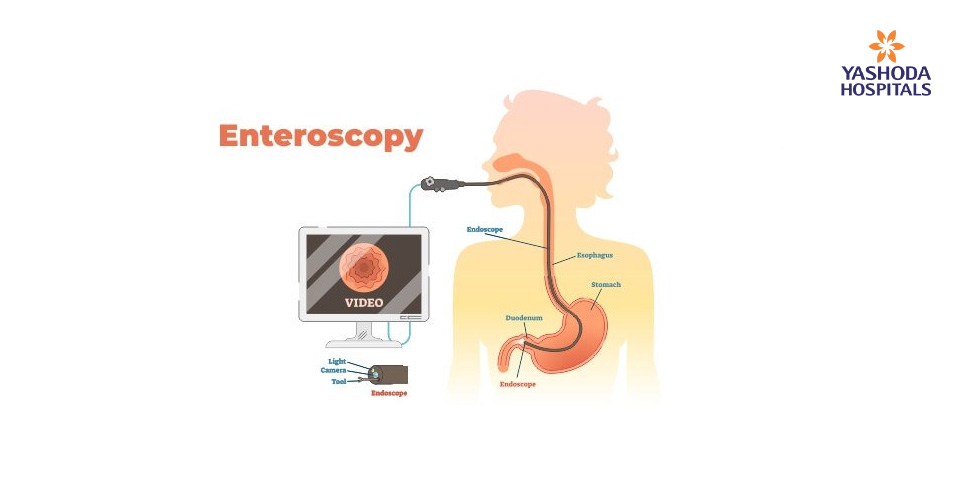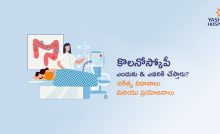

What is enteroscopy?
Enteroscopy is a medical procedure done by a gastroenterologist to diagnose and/or treat problems of the intestines within the digestive system. In this procedure, an endoscope which is a thin, flexible tube with a camera is passed through the mouth or the rectum into the digestive tract within the body. One or two balloons may also be attached to the endoscope which when inflated, helps the doctor to visualize the esophagus, stomach, and intestine closely. The gastroenterologist may also use surgical instruments on the endoscope to perform a biopsy, i.e. remove a small piece of tissue for further analysis or carry out a therapeutic intervention.
Enteroscopes are of different types:
- Double balloon enteroscopy
- Single Balloon enteroscopy
- Push enteroscopy
- Motorized spirus enteroscopy
When is enteroscopy performed?
Enteroscopy is usually recommended when a gastroenterologist suspects some medical concerns of the small intestine. Diagnosis or evaluation of diseases of the gastrointestinal tract is done with enteroscopy without making an incision anywhere in the body.
Some of the common reasons for recommending enteroscopy are:
- Abnormal bleeding from the gastrointestinal (GI) tract
- Abnormal investigation results indicating some disease of the small intestine
- Suspected damage to the intestine from radiation treatment
- Suspected tumor of the intestine or for the screening of polyps
- Obscure GI bleeding
- Unexplained diarrhea
- Unexplained weight loss and malnutrition
- Unexplained abdominal pain
What are some advanced enteroscopic techniques?
The intestine, especially the small bowel may be associated with a wide variety of diseases. However, since long gastroenterologists have found it challenging to diagnose the diseases of the small bowel easily. This is so because the small bowel is usually difficult to access due to its length and tortuous anatomy. In absence of suitable diagnostic tools, conventionally the doctors depended on radiologic tests such as small bowel follow-through with fluoroscopy and a barium-based contrast material and computed tomography to diagnose these conditions. This approach is not only cumbersome but also has many disadvantages; for example, Barium may not be appropriate for everyone. In recent years, the emergence of advanced enteroscopic techniques like capsule endoscopy (CE) has changed diagnostic and therapeutic approaches to the small bowel and other gastrointestinal tract diseases dramatically. Some of these techniques are:
Capsule endoscopy:
Capsule endoscopy is a diagnostic enteroscopic procedure in which a person is asked to swallow a tiny wireless camera placed inside a vitamin-sized capsule. The camera is programmed to take pictures of the tract as it travels through the person’s digestive tract. Thousands of pictures taken by the ingested camera are transmitted to the sensors placed on the abdomen and then a recorder placed on a belt tied around the person’s waist. Once it traverses the tract, the capsule with the camera gets expelled out of the body with the stools. Doctors can interpret the images and decide the treatment plan accordingly.
Capsule endoscopy has very few risks and is considered to be a safe procedure. However, a capsule can become lodged in the digestive tract rather than leaving the body in a bowel movement. This may happen more commonly in certain people with a condition like a tumor, Crohn’s disease or the presence of a narrowing (stricture) in the digestive tract due to some previous surgery.
Spiral enteroscopy:
Spiral enteroscopy was developed in 2007 potentially to provide a simpler and faster technique compared with other device assisted enteroscopic techniques like balloon-assisted enteroscopy. It is a minimally invasive therapeutic technique for procedures of the small bowel. Being endoscopic, it eliminates the need for invasive surgery. The spiral enteroscope consists of a disposable over-tube system that slides over the enteroscope. A spiral located on the tip of the enteroscope is rotated so that the enteroscope can be advanced fast. The spiral also helps gain gentle access into the gastrointestinal tract by pleating the small bowel onto the enteroscope for examination and, if required, treat conditions such as polyps or bleeding. The spiral enteroscope can be mechanical or motorized. It is advanced into the small intestine under the video and fluoroscopic guidance in a clockwise spiral rotation.
The spiral enteroscopy technique is considered to be safe and effective for the diagnosis and treatment of lesions and pathologies within the small bowel. Scientific studies comparing spiral enteroscopy with double and single balloon enteroscopy have demonstrated that the total time of the procedure, depth of insertion and diagnostic yield i.e the proportion of individuals in whom the procedure yielded a definitive diagnosis out of the total number of individuals on whom the diagnostic procedure was performed, were favorable towards spiral enteroscopy.
The most important benefits of spiral enteroscopy are:
- Rapid advancement within the small bowel
- A controlled and stable withdrawal that facilitates good therapy outcomes
The manual spiral enteroscope of 2007 is now completely modified and taken the shape of Motorized Spiral Enteroscopy in 2019-2020
What can one expect before enteroscopy?
A preoperative evaluation is done by the treating doctor based on investigations and clinical information:
Clinical history and physical examination: During the first consultation with the gastroenterologist, he or she will review the person’s medical history and recommend relevant investigations if required.
A brief physical examination will be performed at the time of the consultation. If the doctor determines that the person is a suitable candidate for the procedure, instructions on how to prepare for the procedure shall be provided.
Before the procedure: The doctor would recommend specific preparatory instructions depending on the person’s medical status. Some of the preparatory instructions commonly advised are as follows:
- Any allergies should be disclosed to the treating doctor during the medical history.
- The presence of a pacemaker or defibrillator, any history of previous abdominal surgery, or a history of conditions like bowel obstructions, inflammatory bowel disease should be shared with the treating doctor.
- Women should always inform the gastroenterologist if they are pregnant. Some of the medications may be advised with caution and the doctor may need to take special precautions to minimize any risk to the baby.
- The doctor’s instructions about any prescription medication that a person may be on should be adhered to. For example, if a person is on an anticoagulant or antiplatelet medication, he/she may be recommended to stop it before the procedure.
- A person is asked to sign a consent for the procedure.
- A pre-anesthetic check-up is required to determine fitness for anesthesia
- A liquid diet for a day or two days before the procedure.
- To clear the gastrointestinal tract of food products, it is recommended not to eat or drink anything for at least 12 hours before the procedure. The gastroenterologist may recommend a laxative to clean out the bowel before the procedure.
How is enteroscopy performed?
Enteroscopy is an outpatient-based procedure, which means that the person can go home the same day of the procedure. Depending on the technique being used and the condition being assessed, it usually takes between 45 minutes and two hours for the procedure to complete. Enteroscopy can be performed in the gastroenterology procedure room of a hospital, an independent endoscopy center or an operation theatre within the hospital.
Depending on the type of enteroscopy being performed, general anesthesia may be required or enteroscopy may be done under sedation. The medications are administered intravenously, i.e. through a vein in the arm.
During the procedure, a video may be recorded or pictures taken of the GI tract, that are reviewed in more detail after the procedure is done. If it is suspected that there could be an abnormal pathology in the GI tract like a tumor, the doctor may also take a biopsy, i.e. tissue samples or surgically remove any existing lesions during the procedure. The removal of any tissue or tumor is usually painless.
Usually enteroscopy is performed through the oral route. But if the procedure is incomplete it may be carried out through out the retrograde (anal) route.
Upper Enteroscopy (Antegrade Enteroscopy)
- It is advisable to arrive at least 30 minutes before the scheduled appointment to complete the administrative formalities so that the procedure can be started on time.
- A brief examination is carried out before the procedure to ensure that the person is fit to undergo the procedure.
- An intravenous line is placed, as the enteroscopy procedure is performed under sedation or general anesthesia. Similarly, an arterial line too may be inserted to monitor the pressure during the procedure.
- Monitors are attached to observe the person’s vitals throughout the procedure.
- The procedure is done with the person lying on their left side.
- The gastroenterologist inserts an endoscope into the mouth after numbing the throat, and gradually eases it through the esophagus, down into the stomach and upper digestive tract.
- The person undergoing the procedure may get a feeling of pressure or fullness during this part of the procedure.
- During the procedure, the gastroenterologist may take biopsies i.e small tissue samples or remove polyps or cauterize abnormal lesions that may be the source of symptoms like bleeding.
Lower Enteroscopy (Retrograde Enteroscopy)
Lower enteroscopy is a procedure in which a the enteroscope fitted with a fiber-optic light and camera at the end is passed through the rectum along the full length of the large intestine and then into the small intestine. It is expected to traverse till the lesion is reached in the SI.
What are the risks of enteroscopy?
Even though enteroscopy is considered to be a safe procedure overall when performed by an experienced gastroenterologist, it is not devoid of risks and side effects. Some of the common but mild side effects are:
- Bloating of abdomen
- Minor bleeding
- Nausea
- Some amount of cramping
- Sore throat
Complications after an enteroscopy procedure are rare. Some of these are:
- Internal bleeding
- Pancreatitis
- Tearing in the wall of the small intestine
Certain individuals may have an adverse reaction to the anesthesia, the reason for which enteroscopy is usually avoided or done with extreme caution in obese people, pregnant women or people with chronic diseases of the heart or lung.
Post enteroscopy, the treating gastroenterologist should be consulted immediately if the person experiences:
- Blood in the stool which is more than a few tablespoons in content
- Fever
- Severe pain in the stomach
- Significant abdominal distension
- Vomiting
Conclusion:
The decision for undergoing enteroscopy eventually depends on the patient and his/her family and medical needs. However, an informed consent must be taken after considering the availability of the required expertise and infrastructure in the preferred facility.
Advanced procedures like capsule endoscopy, and spiral enteroscopy should be performed in high-volume centers of excellence with the availability of advanced infrastructure, fully equipped endoscopic suite, trained and experienced gastroenterologists and support staff. The overall cost of enteroscopy gets affected by many factors like the technique being used, underlying medical health of the person, preoperative and postoperative needs.
Persons requiring procedures like gastroscopy and enteroscopy may also have associated swallowing disorders. Such persons also have special nutrition service and lifestyle changes needs. Apart from physician expertise, nutrition plays a large role in the management of the symptoms of gastrointestinal disorders. Lead by gastroenterologists trained and experienced in procedures like enteroscopy, the Center for Gastroenterology at Yashoda hospital, Hyderabad offers comprehensive services including specialized teams for nutrition therapy, intestinal rehabilitation, and nutrition support for persons suffering from gastrointestinal disorders.
Reference:
- Canadian Journal of Gastroenterology. Small bowel enteroscopy. Available at: https://www.ncbi.nlm.nih.gov/pmc/articles/PMC3352842/. Accessed on February 17, 2020
- American Society of Gastrointestinal Endoscopy. Available at: https://www.giejournal.org/article/S0016-5107(15)02539-0/pdf. Accessed on February 17, 2020
- Which Type of Deep Enteroscopy Procedure Is Best? Available at: https://www.jwatch.org/na44561/2017/07/17/which-type-deep-enteroscopy-procedure-best.Accessed on February 17, 2020
About Author –
Dr. B. Ravi Shankar, Consultant Medical Gastroenterologist, Yashoda Hospital, Hyderabad
MD, DNB, DM (Gastroenterology)
About Author
Recent Posts
రక్తదానం: అర్హులు, ప్రయోజనాలు మరియు అపోహల గురించి సంక్షిప్త సమాచారం
మనిషి బ్రతకడానికి ప్రాణవాయువు ఆక్సిజన్ ఎంత అవసరమో రక్తం కూడా అంతే అవసరం. రక్తం, శరీరంలోని ప్రతి కణంతో అనుక్షణం…
నరాల సంబంధిత వ్యాధుల రకాలు, కారణాలు, లక్షణాలు & నిర్ధారణ పరీక్షలు
నరాల సంబంధిత రుగ్మతలు అంటే నాడీ వ్యవస్థ మొత్తం మీద ప్రభావం చూపే వ్యాధులు. నాడీ సంబంధిత పరిస్థితులు ఇప్పుడు…
Endovascular Surgery: Minimally Invasive Solution to Vascular Disease
Endovascular surgery is a revolutionary advancement in medical technology wherein doctors can treat almost any…
పల్మోనరీ ఎంబోలిజం: లక్షణాలు, కారణాలు మరియు చికిత్స విధానాలు
పల్మోనరీ ఎంబోలిజం అనేది చికిత్స మీద ఆధారపడిన ఒక తీవ్రమైన పరిస్థితి, ఇది సాధారణంగా ఊపిరితిత్తులకు ప్రయాణించే రక్తంలో గడ్డకట్టడం…
Rhinoplasty: Understanding the Nose Surgery Procedure and Its Benefits
Rhinoplasty is commonly known as a nose job that is usually designed to reshape a…
Is Spine Surgery Safe? Exploring Minimally Invasive Techniques and Recovery
Spine surgery is a source of fear for most people, yet it has undergone significant…


